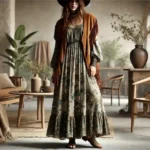Sustainable fashion is revolutionizing the way we think about clothing. With growing awareness of environmental issues and a desire for more ethical practices, eco-friendly clothing trends are becoming increasingly popular. This article explores the latest trends in sustainable fashion, offering insights into how you can incorporate eco-friendly choices into your wardrobe while supporting a healthier planet.
The fashion industry is one of the largest contributors to environmental pollution. From the excessive use of water in textile production to the harmful chemicals used in dyeing processes, traditional fashion practices have significant environmental impacts. However, sustainable fashion aims to address these issues by promoting eco-friendly materials, ethical production methods, and conscious consumer behavior. By embracing these trends, you can make a positive impact on the environment and support brands that prioritize sustainability.
Buy less, choose well, make it last.
— Vivienne Westwood
This quote by Vivienne Westwood emphasizes the importance of mindful consumption in sustainable fashion. By choosing quality over quantity, we can reduce waste and promote a more sustainable lifestyle.
The Rise of Eco-Friendly Materials
Eco-friendly materials are at the heart of sustainable fashion. These materials are sourced and produced in ways that minimize their environmental impact, making them a better choice for both people and the planet.
Popular Sustainable Fabrics
- Organic Cotton: Grown without synthetic pesticides or fertilizers, reducing environmental damage.
- Bamboo: A fast-growing, renewable resource that requires minimal water and pesticides.
- Hemp: Highly durable and requires less water and fewer pesticides than conventional cotton.
- Tencel: Made from sustainably harvested wood pulp, it is biodegradable and produced in a closed-loop process.
The greatest threat to our planet is the belief that someone else will save it.
— Robert Swan
Robert Swan’s quote highlights the collective responsibility we have in protecting the environment. Sustainable fashion is one way we can contribute to this effort.
Ethical Production Practices

Sustainable fashion also focuses on ethical production practices, ensuring fair treatment of workers and minimizing environmental harm throughout the manufacturing process.
Key Ethical Practices
- Fair Trade: Ensuring fair wages and safe working conditions for all employees involved in production.
- Local Manufacturing: Reducing carbon footprints by producing clothing closer to the point of sale.
- Recycled and Upcycled Materials: Using post-consumer waste and discarded materials to create new garments, reducing landfill waste.
Trends in Sustainable Fashion
Eco-friendly clothing trends are not only about the materials used but also about promoting a sustainable lifestyle through fashion choices. Here are some current trends in sustainable fashion.
Minimalist Wardrobes

A minimalist wardrobe focuses on owning fewer, high-quality pieces that can be mixed and matched. This approach promotes mindful consumption and reduces waste.
Benefits of Minimalist Wardrobes:
- Reduces clutter and simplifies wardrobe management.
- Encourages thoughtful purchasing decisions.
- Promotes investment in durable, timeless pieces.
Vintage and Second-Hand Shopping
Buying vintage or second-hand clothing is a sustainable way to refresh your wardrobe. It extends the life of garments and reduces the demand for new clothing production.
Benefits of Vintage Shopping:
- Unique, one-of-a-kind finds.
- Reduces textile waste.
- Often more affordable than new clothing.
Fashion is what you’re offered four times a year by designers. And style is what you choose.
— Lauren Hutton
Lauren Hutton’s quote reminds us that true style is about personal choice and individuality, which can be expressed through sustainable fashion choices.
Sustainable Fashion Brands to Watch
Several brands are leading the way in sustainable fashion, offering stylish, eco-friendly options for conscious consumers.

Notable Sustainable Fashion Brands
- Patagonia: Known for its commitment to environmental activism and sustainable practices.
- Reformation: Focuses on sustainable fabrics and ethical production methods.
- Everlane: Prioritizes transparency in its supply chain and sustainable materials.
- Eileen Fisher: Emphasizes organic and recycled fabrics, fair trade, and local production.
DIY and Upcycling: Personalizing Sustainable Fashion
DIY and upcycling are creative ways to personalize your wardrobe while promoting sustainability. By repurposing old garments, you can create unique pieces and reduce waste.
Tips for Upcycling Clothing
- Patchwork and Embroidery: Add patches or embroidery to old clothing to give it new life.
- Alterations: Tailor garments to fit better or transform them into entirely new pieces.
- Dyeing: Use natural dyes to refresh faded clothing and add vibrant colors.
The most sustainable garment is the one already in your wardrobe.
— Orsola de Castro
Orsola de Castro’s quote emphasizes the importance of making the most of what we already own, promoting sustainability through mindful consumption and creative reuse.
The Future of Sustainable Fashion
The future of sustainable fashion looks promising as more consumers and brands commit to eco-friendly practices. Innovations in materials, technology, and production methods continue to drive the industry forward.
Innovations in Sustainable Fashion
- Biodegradable Fabrics: Development of materials that break down naturally, reducing landfill waste.
- 3D Printing: Reduces material waste and allows for customizable, on-demand production.
- Circular Fashion: Aims to create a closed-loop system where garments are recycled and reused continuously.
For more insights into sustainable fashion, visit Fashion Revolution and explore eco-friendly brands at Good On You.















